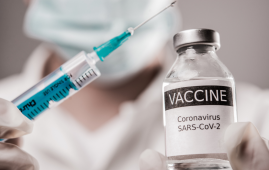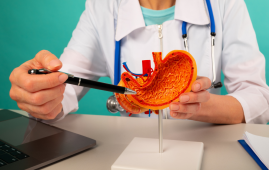

Scientists from the Princess Máxima Center for Pediatric Oncology and the Hubrecht Institute in the Netherlands have discovered new details about fibrolamellar carcinoma (FLC), a rare kind of childhood liver cancer.
Their findings, which were published today in Nature Communications, could aid in the development of new drug therapies in the future. The researchers were able to better grasp tumor biology and the biological repercussions of diverse DNA modifications thanks to mini-organs and the molecular scissor’ technology CRISPR-Cas9. It also revealed the likely cell of origin for one of the FLC tumor types.
Fibrolamellar carcinoma (FLC) is a kind of liver cancer that primarily affects teenagers and young adults. Fibrolamellar carcinoma is certainly rare, affecting one in every five million people each year. The survival rate is low. New forms of treatment are desperately needed to change this. Dr. Benedetta Artegiani, research group head at the Princess Máxima Center for Pediatric Oncology, and Dr. Delilah Hendriks, a researcher at the Hubrecht Institute, collaborated on a new study on fibrolamellar carcinoma employing cutting-edge technology. This enabled the researchers to better grasp the biological ramifications of various FLC mutations and to examine the biology of the malignancies. This new information is required to understand why cancers form and to discover potential targets for better disease treatments.
Artegiani says, “We used healthy human liver organoids, mini-livers grown in the lab, in our research. We developed a series of organoids, all with different DNA changes, and mutations, that had previously been linked to FLC. We changed the genetic background of the organoids using the DNA modification technique CRISPR-Cas9, which works as a ‘molecular scissor.’ Due to its rarity, there is not much tumor tissue available for research. Thanks to this technique we were able to study this tumor type.”
Artegiani and Hendriks created the liver organoids by employing CRISPR-Cas9 to alter the protein kinase A (PKA). PKA is a complicated signaling protein that can turn other proteins on and off. This ‘protein switch’ is composed of many parts, each of which is encoded by a distinct gene. Changing the function of the various units via genetic alterations appears to be critical for the beginning of FLC.
The mutant fusion gene DNAJB1-PRKACA was present in the organoids. This DNA alteration is frequently observed in FLC malignancies. Hendriks says, “When reconstructing this mutation in the organoids, we saw that it indeed is able to mirror multiple features of the tumors we see in patients with FLC. Yet, this single mutation caused a rather mild effect on the overall cellular and molecular behavior of the liver cells.”
The situation completely changed when they introduced another set of DNA changes, also found in patients with FLC. Artegiani says, “This second background not only contains a mutation in one of the PKA genes, PRKAR2A, but also in an additional gene called BAP1. In this case, the organoids presented features typical of aggressive cancer. This suggests that different genetic FLC backgrounds lead to different degrees of tumor aggressiveness.”
Next to this, the greatly enhanced transforming effect caused by the BAP1 and PRKAR2A DNA changes allows the cells to adapt to different environments. This possibly explains the uncontrolled growth of cells during FLC tumor formation.
The researchers concluded that although mutations in the PKA genes are crucial, they might not be sufficient for the development of FLC. Hendriks says “These findings open the possibility to look for other factors to occur together with PKA mutations in FLC tumors. This could be potentially exploited for possible future therapies for this form of childhood cancer.”
Understanding the biology of the cancer itself is also necessary for developing novel medicines. One of the first tasks is determining which cell type causes the cancer: the cell-of-origin. Understanding the significance of individual gene flaws in the genesis of FLC and the original cell may be critical to understanding how the tumor will behave later on.
However, during the study, this turned out to be particularly difficult for FLC. “The main cause is that these tumors present features of both hepatocytes and ductal cells, the two most important cells in the liver. Our organoids showed that the cooperation of PRKAR2A and BAP1 transformed an originally healthy hepatocyte into a ductal cell, with increased cancer stem cell features,” says Artegiani.
“This transformation of a cell type into another one is called transdifferentiation. This is a particularly interesting phenomenon that could happen in various tumors and makes the identification of the cell of origin particularly difficult. However, with the use of our models, we were able to uncover the hepatocytes as the probable cell-of-origin.”
Altogether, this study greatly advances the understanding of FLC and paves the way for further research on how to better treat this rare cancer type. The insights into genetic defects could potentially lead to new therapies for children with this disease. And understanding the importance of specific gene faults in the initiation of FLC could in the future also help to better understand tumor heterogeneity and response between patients.
more recommended stories
 Transplant Drug Shows Promise in Slowing Alzheimer’s in Seizure Patients
Transplant Drug Shows Promise in Slowing Alzheimer’s in Seizure PatientsProtein imbalances, which heighten the excitability.
 Fentanyl Inhalation: Brain Damage Risks
Fentanyl Inhalation: Brain Damage RisksAfter treating a middle-aged man who.
 Enhanced Immune Response in New COVID-19 Vaccines
Enhanced Immune Response in New COVID-19 VaccinesAn improved vaccination offers an enhanced.
 Bioresorbable Wireless Sensor for Early Stomach Leakage Detection
Bioresorbable Wireless Sensor for Early Stomach Leakage DetectionIn a recent publication in Scientific.
 Neurocardiac Connectivity in Depression Treatment
Neurocardiac Connectivity in Depression TreatmentHeart rate deceleration and sadness may.
 Antioxidants: Impact on Quality of Life in Acne Vulgaris
Antioxidants: Impact on Quality of Life in Acne VulgarisA recent study published in the.
 Palliative Care Disparities for Opioid Users: Study Findings
Palliative Care Disparities for Opioid Users: Study FindingsIn contrast to individuals devoid of.
 Brain Pulsations Linked to High BMI
Brain Pulsations Linked to High BMIAccording to a new study from.
 Brain Age Estimation: EEG Advancements in Neurology
Brain Age Estimation: EEG Advancements in NeurologyTo estimate brain age using EEG.
 Unlocking Ketogenic Diet for Epilepsy Management
Unlocking Ketogenic Diet for Epilepsy ManagementExploring the Therapeutic Potential of Ketogenic.

Leave a Comment